Dawn Birdwatch: Sun 12th May 2024
Wadsley's birds watch a record turnout of early morning ornithologists. The local charity that prevented a steel works at Edale. And: your 4th Secret Seating puzzle.
Morning. 5 a.m. is not that early, you’ll discover today. In May, Blackbirds are up long before then, but the early(ish) birdwatcher still catches the Willow Warbler. The ridiculously early bird walk of Wadsley Common saw one of its highest ever turnouts yesterday, and this publication was there in dawn’s early light to listen and learn.
We also strolled along to the 100th anniversary celebration of CPRE Peak District & South Yorkshire, the local countryside charity too many of us have never heard of.
A new book details how the local Campaign for Rural England has protected the landscapes of rural Sheffield and Peak District from industrialists, frackers, road builders and motor racing enthusiasts over two centuries.
I was out at work for our social enterprise at 4.15 yesterday morning, and can only put in the time to bring you these stories thanks to our wonderful paying subscribers.
Despite rising costs, I’ve so far kept subscriptions as low as I can to encourage you to join in once you’ve had a few weeks for free. This publication has no other income other than the readers paying for it, so if you’re not a wonderful full subscriber yet, it would be really nice if you could join us.
Early Birds
Imagine, if you will, all the men of the northern hemisphere opening their front doors as the sun rises on a May morning and shouting at all the other men in the northern hemisphere.
‘That’s what the birds are doing,” explains John Robinson. “They’re saying ‘I’m here! This is mine!’”
May is the pinnacle of bird activity, says John, and while the females of most species are busily preparing themselves for motherhood, the prospective fathers are notifying their rivals by singing again and again, every morning, to tell males of the same species to avoid their patch. And they begin when the sun is starting to rise, hence the 5am start for John’s annual Dawn Chorus Bird Walk of Wadsley Common.
For reasons unclear, Blackbirds are usually the first birds to wake up and sing, and I could hear them shouting out from the darkness behind Walkley terraces as I travelled across the city.
Some birders say 4 am or earlier is really the best time to catch the full dawn chorus experience, by waiting quietly for the first song of the morning, and hearing as it launches the day in your woodland or garden for all the other birds of Sheffield.
John and his wife Anne have been leading bird walks for many years, as local members of the RSPB wildlife charity, and founding members of the Wadsley and Loxley Commoners, who began helping the council conserve the 100 acre common thirty years ago.
I’ve joined them several times, and its usually been grey and misty, but not today where almost thirty people have gathered in the early morning sun at the lower edge of the common ready to hear the birds and John’s easy going anecdotes about his encounters with the 91 species recorded on the common. “I’m not guaranteeing all 91 today,” he warns.
Anne tells me this is the highest ever turnout, and although there are plenty of elder birders, as you often find at such events, there are quite a few younger people, testament to a nationwide repositioning of bird watching as a respectable non-anorak style activity for all ages of people interested in the plight of the natural world.
The work on Wadsley Common may well be helping local populations hold their numbers, says Theo Hunter, a student in his twenties who began his ecological career wandering round the common on his doorstep.
One of the first birds we hear is the Linnet, an indicator species for the lowland heath habitat the Commoners are trying to preserve by removing invasive Silver Birch and Oak trees, and Bracken, to allow heathland plants like Heather and Bilberry to thrive.
“We’re doing all this work, and seeing and hearing the Linnet tells us we’re probably getting it right,” says John.
A Kestrel and then a Cormorant fly over, to some excitement, and John notes the ‘energetic’ song of a tiny Wren nearby, with 103 notes in seven seconds, he says.
Higher up we meet the first Willow Warbler singing from the woods. Native birds like Robins and Blackbirds have been singing since February, John says, but now they’re joined by highly vocal migrants from Africa.
“These warblers have travelled 7,000 miles to sing on Wadsley Common,” he says. “A few weeks ago that bird was looking down on Zebras and African Elephants.”
In May on Wadsley Common, you can’t move for Willow Warblers, he adds happily.
We soon pick up other migrant warblers, like the Chiffchaff (it goes ‘chiff, chaff’, we learn) and then try and differentiate the sounds of a Blackcap and Garden Warbler one after the other. The songs are similar, but a practised birder will know the Blackcap has a more melodic and measured song than the Garden Warbler.
“We call it the Garbled Warbler,” says Theo helpfully. “A bit like the sound of a computer hacker from older TV movies.”
“Merlin says it’s a Garden Warbler,” says an attentive listener. He’s referring to an app on his smartphone rather than a nearby aged wizard.
Merlin is an exciting new development for birdsong lovers, a new application that you hold in the air on a bird walk, which then informs you what you’re listening to. John approves, as a way of bringing the joys of bird identification to a wider public. But it’s not without its faults.
“One man told me he’d heard an American Robin on the common,” John tells me. “Oh, I said, that’s quite rare. Are you sure? Oh yes, he said, Merlin identified it.”
It’s an American app, John explains, and does make mistakes. They did the same thing in Mary Poppins, Anne reminds me. The robin that sang ‘A Spoonful of Sugar’ with Julie Andrews in the film of sixty years ago was the larger American variant, so as not to confuse the Disney audience as it perched on her finger in a London garden.
Buzzards fly over, and another Kestrel, and we spend some minutes trying to spot two tuneful Song Thrushes that lead us up the common, until one finally reveals itself to John’s telescope.
We see cleared areas full of Bilberry, where the arrival of the Bilberry Pug Moth on the common is another sign of good conservation work. And historian Nick Peck shows us an innocuous hole in a path-side stone, which the Commoners now believe is the original home of a large track side cross, part of a series of crosses carried away during the reformation 500 years ago.
All along John has been preparing us for Yellowhammers, now a rarity in many places. It was once a common farmland bird, but is now a ‘red list’ species of ‘conservation concern’, with a national population decline caused, it seems, by farming practices that reduce the amount of seed available over winter.
But the commons of Wadsley and Loxley are proud to host Yellowhammers, particularly near the open land at the top. The Yellowhammer is the jewel in the common’s crown, John says, promising us we’ll see one.
We reach the top near Long Lane, where Wadsley common merges into Loxley, and wait.
“Listen! A Curlew,” says John, indicating the valley below. “It’s your bionic ears,” says Anne, as we all turn our heads in every direction to try and hear anything.
But we’re focussing on the Yellowhammer, listening for a call that goes: “A little bit of bread and no cheese,” says John, as we scan the nearby trees. After a minute or two, he rummages in his pocket for a small pen-like device, and presses a button which plays the required call loud enough for nearby male Yellowhammers to hear.
Within moments, there’s a bright yellow blur behind him, and a song that with some imagination does indeed call out for bread, but with a pronounced emphasis at the end on avoiding dairy products. The obliging Yellowhammer, which has clearly witnessed all this many times before, sits patiently while John aims his telescope so we can all marvel at its canary-like plumage.
He‘d get drummed out of serious ornithological circles for luring Yellowhammers this way, John notes, but the bird soon moves on, leaving two dozen happy and enthused bird conservationists behind him.
The sounds of Linnets and Blackbirds and Wrens and Yellowhammers seem to be telling us on this bright spring morning that if local conservationists get themselves busy and organised, like the Wadsley & Loxley Commoners, you could keep all these birds singing at each other for generations to come.
I’ll try and provide upcoming bird walks and events in our regularly updated “What’s On Out There” posts. If you know of any early dawn or other events, do let me know at bbobillsmothers@gmail.com. And the Wadsley Common BioBlitz events continue next weekend with more bird and nature walks.
And sorry for the hour later arrival of this post. I had to catch up on my sleep somehow.
100 Years Of Landscape Battles
CPRE PDSY may have an impenetrable acronym of a name, but the Campaign for Rural England (Peak District & South Yorkshire) had much to celebrate at its 100th birthday at Whirlow Brook Hall last week.
We ran a post about the new book by poet Helen Mort on CPRE PDSY founder Ethel Haythornthwaite for full members a few weeks ago - the book was launched at last week’s event, attended by several dozen supporters of the charity from Sheffield, the Peak District and beyond.
On the same evening another small book was launched: ‘100 Years That Shaped The Countryside’ by Bill Bevan, which I think will be available from CPRE PDSY soon.
I hope to speak to the charity’s CEO Tomo Thompson for a longer feature in the next week or two, but in the meantime this book does a grand job of detailing some of the things CPRE PDSY have achieved over the last 100 years that outdoors folk appreciate without even knowing about them.
Without our local countryside charity, we might have seen rubbish dump sites at Redmires, Ringinglow and the Rivelin Valley, a motor racing circuit near Hartington, a steel works at Edale, and several additional motorway-style roads across the Peak District. The charity also fought for the country’s first ever green belt (around Sheffield) and was instrumental in buying Longshaw and Blacka Moor for the city.
More recent campaigns have been fighting off fracking proposals and working with electricity companies to bury power lines underground.
The centenary celebrations will last all year, and I’ll have more in forthcoming posts.
Secret Seating (4)
The next ‘where is that secret seat?’ competition for keen readers is above. Where could this relaxing seating arrangement be?
The last Secret Seating prize was won by Ben Nicholson, who correctly identified Carr Woods in the photo by reader Simon Geller. We have another reader picture coming soon (courtesy of John Wardle, who hasn’t yet told me where it is - and I have no clue, John, so please help!)
Your answers to this week’s Secret Seating in the comments please!
If you’ve enjoyed this post, please do share it with your mates.
(Keeping these Sunday posts free for all is made possible by our scores of paid up full subscribers - thanks so much to all of you).
Selected What’s On Out There (from Sun 12th May)
See our full listings service here. It’s updated every few days after I’ve put hours in to save your faffing.
Sat 11th - Sun 12th - Open Up Sheffield, local artists open their studios across the city
Sun 12th - Wildflower Walk at Parkwood Springs - 10.30 am start at Shirecliffe Road
Tues 14th - Graves Park Digging Deeper For All - Recording Old Trees (Meet Charles Ashmore car park)
Thur 16th - SRWT Volunteer Work Day - Blacka Moor
Sat 18th - Parkwood Springs Conservation Morning (meet Shirecliffe Rd entrance 10am)
Sat 18th - Wadsley BioBlitz Bird Walk
Sat 18th - Post parkrun SUDS Walk at Manor Fields - explaining the new ponds and SUDS features
Sat 18th - Sustrans Rangers volunteer litter and maintenace (Beeley Woods - 11am-1pm ish, https://what3words.com/chop.noted.hills - email: sustransrangerssheffield@gmail.com)
Sat 18th - Loxley Cemetery work day
Sat 18th - Graves Park Digging Deeper For All - Heritage Walk (Meet Charles Ashmore car park)
Sat 18th - Kidical Mass cycle ride for kids and families
Thanks for reading. If you’ve been a free reader for a while, now’s the time to think on: it takes a lot of time, and quite a few bills, to put these posts together, and costs you just £4 a month (less if you go annual) to help make it happen. Thanks.




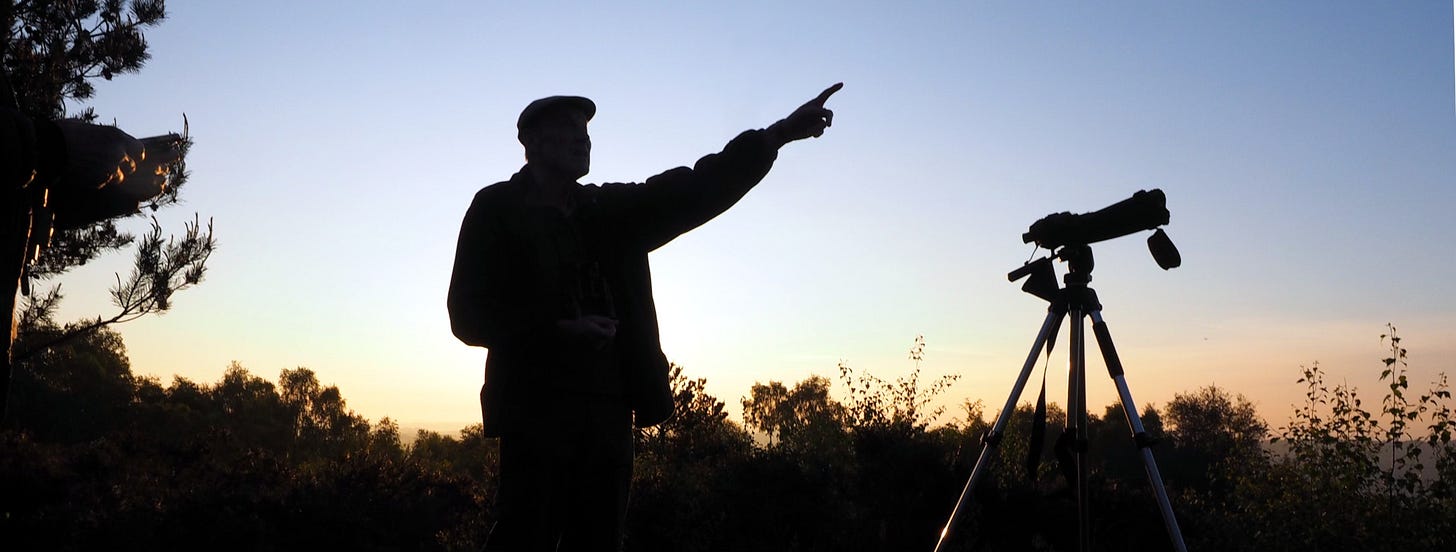

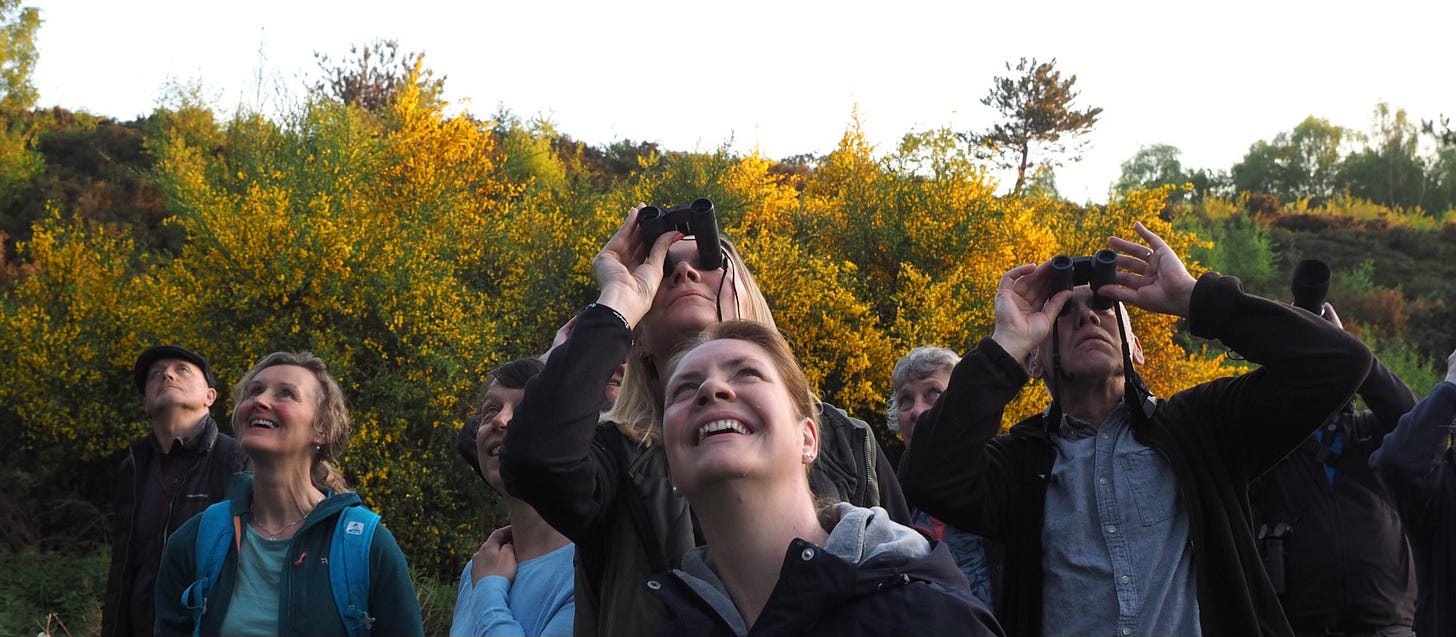


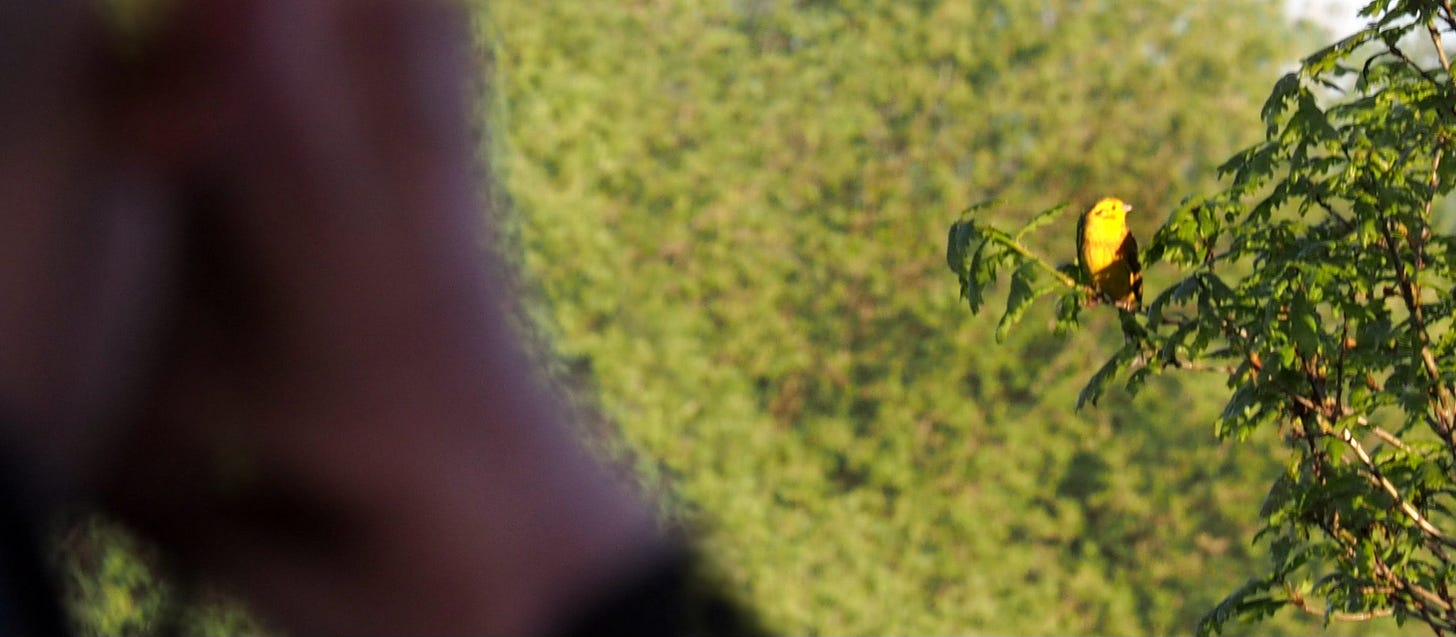
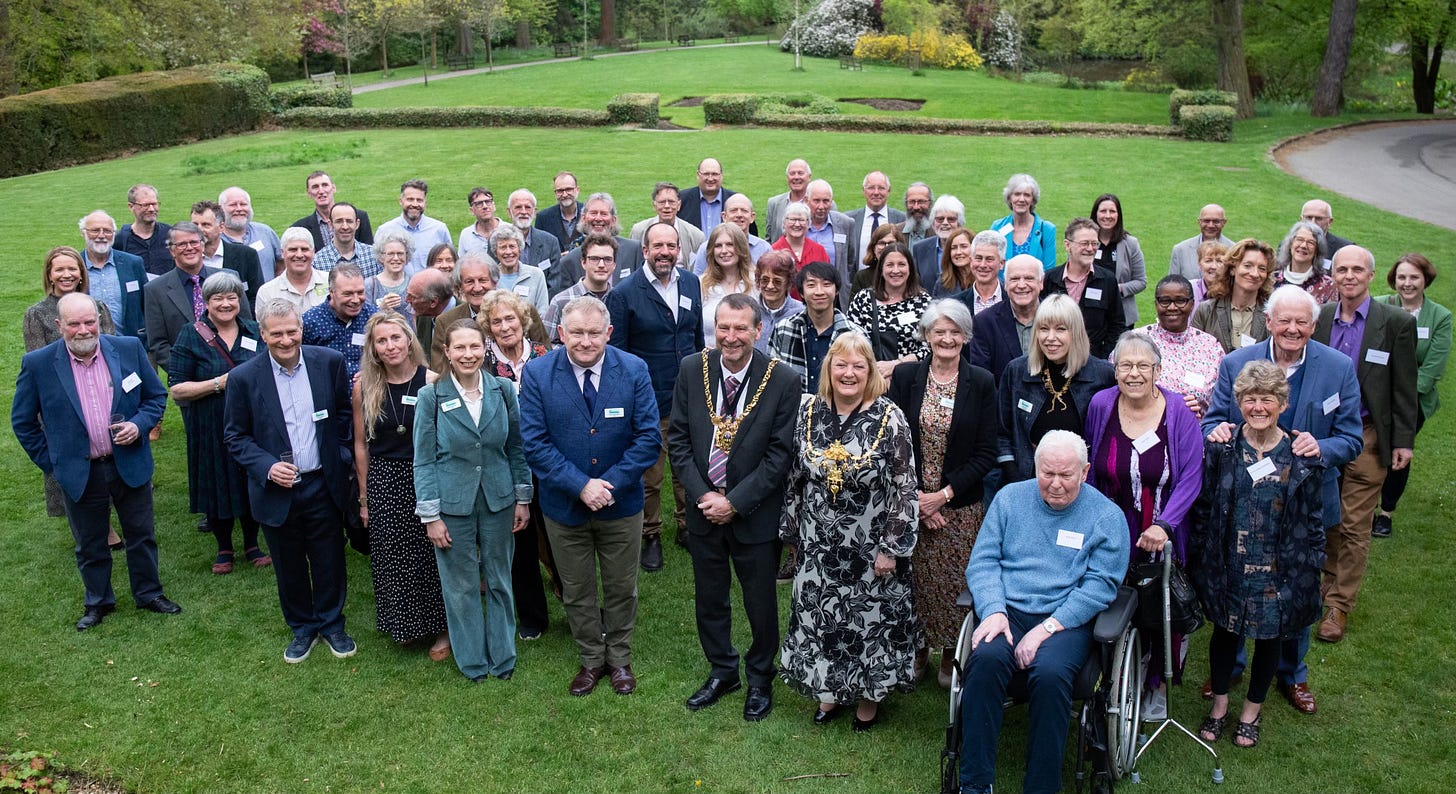
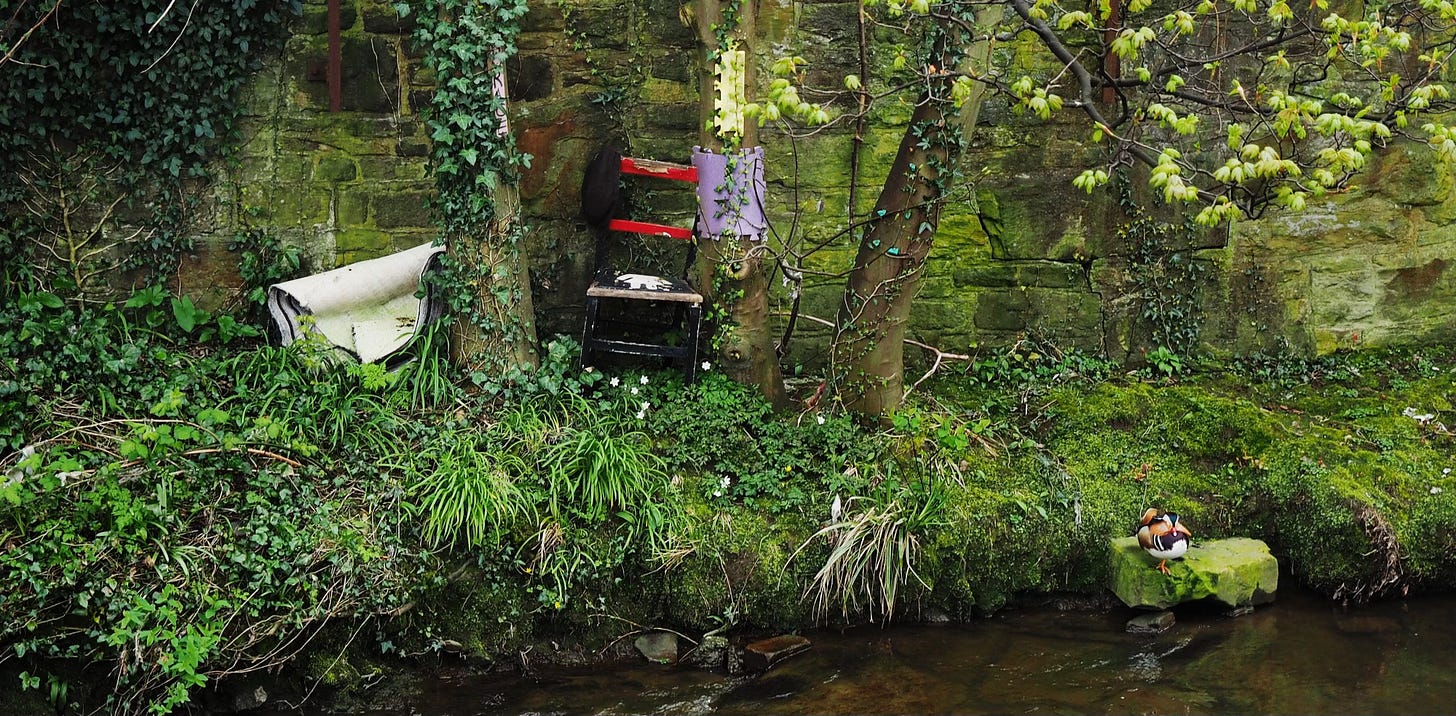
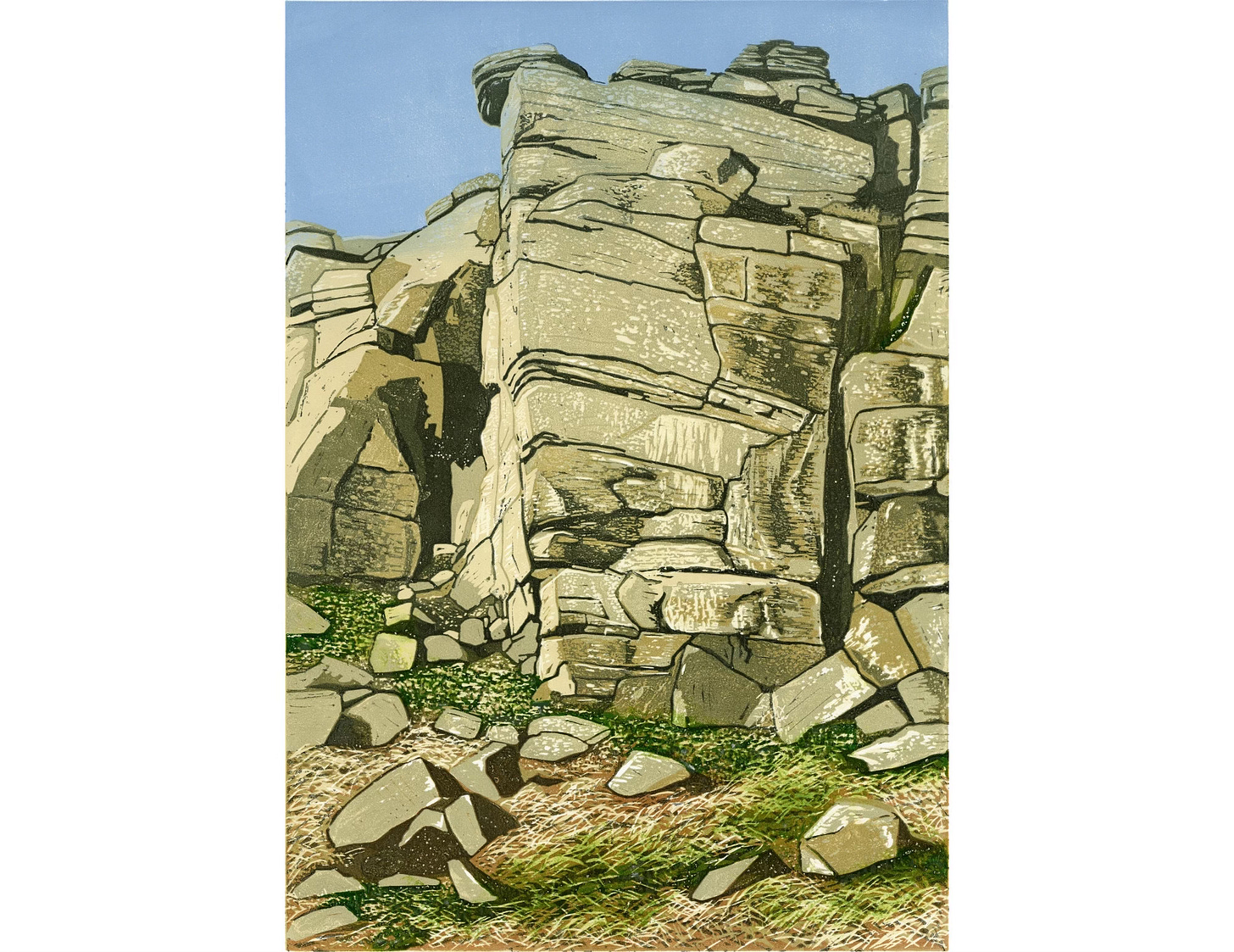
I remember as a child wandering along quiet lanes in the Cheshire countryside, and hearing yellowhammers and skylarks. Then as an adult, I used to drive along the M6/M56/M53 to visit my parents, little realising how close I was to the paths I used to wander. The motorways made the journey much quicker, but these days I feel quite bad that I was just the sort of person these motorways were build for. I wonder how much I would have been prepared to give up to preserve the countryside and the wildlife as it was……
I still dream of those quiet lanes 🥹.
Another great post David, thank you. I'm pretty sure that the Secret Seat is on the right bank of the River Sheaf at Broadfield Road. Note also the male Mandarin Duck in the photo, one of the 20 or so in what has become a thriving community of these somewhat ostentatious birds.